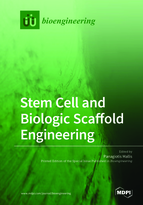Stem Cell and Biologic Scaffold Engineering
A special issue of Bioengineering (ISSN 2306-5354). This special issue belongs to the section "Regenerative Engineering".
Deadline for manuscript submissions: closed (31 July 2019) | Viewed by 46281
Special Issue Editor
Interests: immunobiology of stem cells; molecular genetics of HLA; tissue-engineered small-diameter vascular grafts; immunobiology of biological scaffolds; mesenchymal stromal cells; hematopoietic stem cells biology
Special Issues, Collections and Topics in MDPI journals
Special Issue Information
Dear Colleagues,
Tissue engineering and regenerative medicine is a rapidly evolving research field, which combines effectively stem cells and biologic scaffolds in order to replace damaged tissues. Biologic scaffolds can be produced through the removal of resident cellular populations using several tissue engineering approaches such as the decellularization method. Indeed, the decellularization method aims to develop a cell-free biologic scaffold, while the extracellular matrix (ECM) could be preserved intact. Furthermore, biologic scaffolds have been investigated for in vitro potential of whole organ development. Currently, clinical products composed of decellularized matrices such as pericardium, urinary bladder, small intestine, heart valves, nerve conduits, trachea, and vessels are being evaluated in order to be used in human clinical trials.
Tissue engineering strategies require the interaction of biologic scaffolds with cellular populations. Among them, stem cells are characterized by unlimited cell division, self-renewal, and differentiation potential, distinguishing themselves as a frontline source for the repopulation of decellularized matrices and scaffolds. Under this scope, stem cells can be isolated from patients, expanded under Good Manufacturing Practices conditions (GMPs), used for the repopulation of biologic scaffolds, and, finally, returned to the patient. The interaction between scaffolds and stem cells is thought to be crucial for their infiltration, adhesion, and differentiation into specific cell types. In addition, biomedical devices such as bioreactors contribute to the uniform repopulation of scaffolds.
Until now, a remarkable effort has been performed by the scientific society in order to establish the proper repopulation conditions of decellularized matrices and scaffolds. However, parameters such as stem cell number, in vitro cultivation conditions, and specific growth media composition need further evaluation. The ultimate goal is the development of “artificial” tissues similar to native ones, which is achieved by combining properly stem cells and biologic scaffolds, thus bringing them one step closer to personalized medicine.
This Special Issue will accept original research articles and comprehensive reviews that deal with the use of stem cells and biologic scaffolds that utilize state-of-the-art tissue engineering and regenerative medicine approaches.
We look forward to receiving your valuable contributions to this Special Issue.
Dr. Panagiotis Mallis
Guest Editor
Manuscript Submission Information
Manuscripts should be submitted online at www.mdpi.com by registering and logging in to this website. Once you are registered, click here to go to the submission form. Manuscripts can be submitted until the deadline. All submissions that pass pre-check are peer-reviewed. Accepted papers will be published continuously in the journal (as soon as accepted) and will be listed together on the special issue website. Research articles, review articles as well as short communications are invited. For planned papers, a title and short abstract (about 100 words) can be sent to the Editorial Office for announcement on this website.
Submitted manuscripts should not have been published previously, nor be under consideration for publication elsewhere (except conference proceedings papers). All manuscripts are thoroughly refereed through a single-blind peer-review process. A guide for authors and other relevant information for submission of manuscripts is available on the Instructions for Authors page. Bioengineering is an international peer-reviewed open access monthly journal published by MDPI.
Please visit the Instructions for Authors page before submitting a manuscript. The Article Processing Charge (APC) for publication in this open access journal is 2700 CHF (Swiss Francs). Submitted papers should be well formatted and use good English. Authors may use MDPI's English editing service prior to publication or during author revisions.







